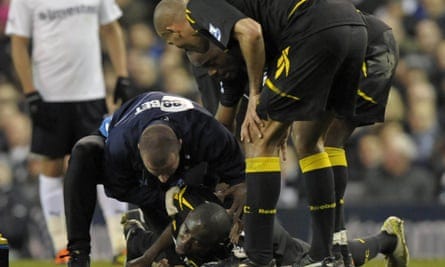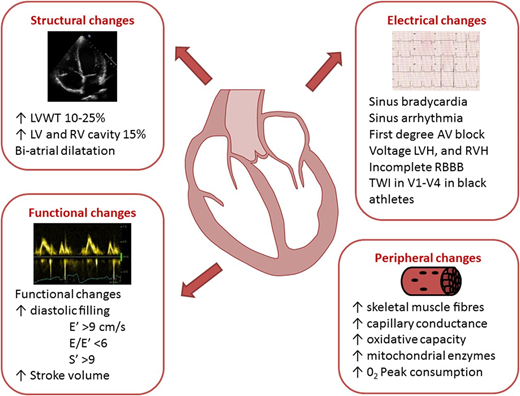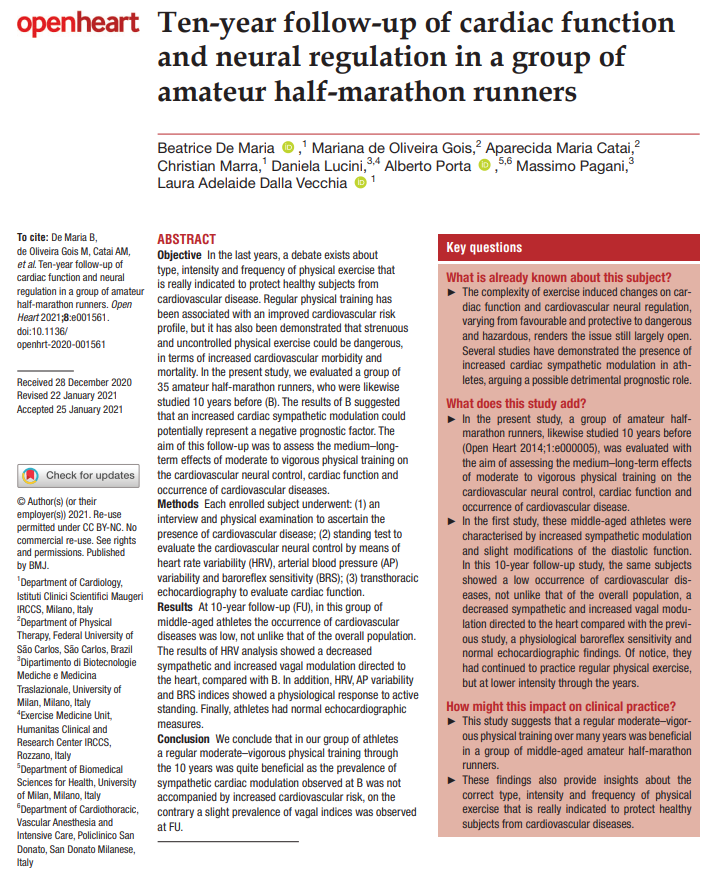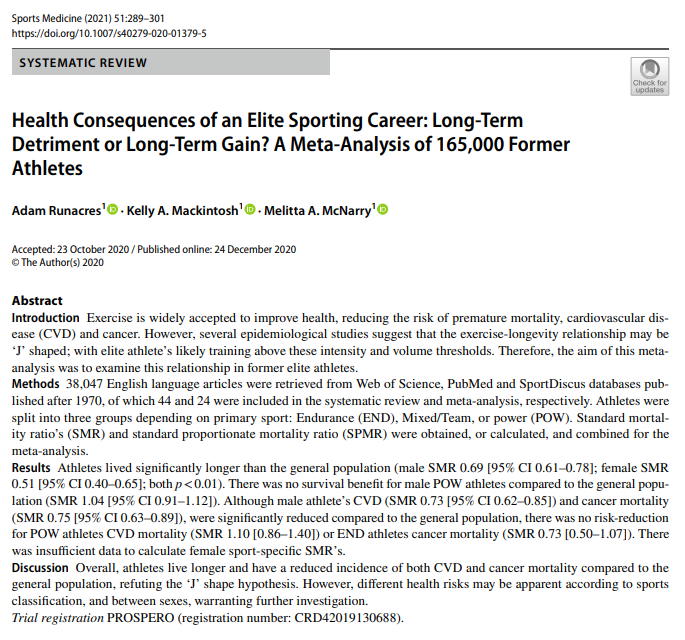I am sure you have seen some worrying headlines that too much exercise is bad for you. Authors of the Copenhagen City Heart Study (Schnohr 2015) were first to propose a reverse or J shaped relationship between physical activity and mortality ie, the mortality risk *reduction* is lost at a high threshold of physical activity (Citation) and maybe at a certain level exercise could become dangerous!!

Indeed some authors have even advised that the daily amount of vigorous physical activity should not exceed 50 mins. I know that will come as a relief to many 😂
Worrying Case of Fabrice Muamba

In March 2012, footballer Muamba suffered a cardiac arrest during an FA Cup match between Bolton and Tottenham Hotspur, from which he recovered despite his heart having stopped for 78 minutes. But remember:
Sudden cardiac death (SCD) is rare ∼1 in 50,000 in young & middle aged marathoners
In younger athletes there is a worry about hypertrophic obstructive cardiomyopathy (HCM) and recently myocarditis, in older athletes there is a worry about atrial fibrillation (AF) a coronary artery calcifications (CACs) which are basically signs of repair of older occlusions.
Wait, I thought exercise is good for you right?
Definitely! Exercise is good for you! Exercise is linked with improved survival, low comorbidity and markedly better quality of life. Exercise reduces the risk of prostate and breast cancer, prevents osteoporosis and dementia and most mental health condition. Some say exercise is the most effective, accessible, and cheapest therapy a physician can prescribe……if only people followed the advice 😂
and is Exercise also good for your Heart?
Yes, the heart naturally goes through adaptive changes in endurance athletes including: Left ventricular hypertrophy > Right ventricular hypertrophy >high left atrial volume> Intraventricular septum thickness (IVST)

In athletes the heart is healthier and has superior function based on
improved stroke volume
Increased ejection fraction
Improved heart rate
Improved Heart rate variability (HRV)
Unusual heart and ECG changes in Athletes
A study of over 1300 white Italian Olympic athletes demonstrated that 14% had dilated cardiomyopathy. Rarely, some invasive studies found temporary postexercise changes in cardiac function (Ref). Some groups also measured cardiac troponin (cTn), which are highly cardio-specific markers of cellular damage and can be elevated after exercise. But exercise-induced cTnI release is strongly related to previous training experience, cNT is low with adequate training (citation).
ECG measures the electrical rhythm of the heart, and nowadays even the Apple Watch is offering this! More complex cardiac arrhythmias have also been reported in small numbers of endurance athletes (ref) . One example is an inverted T-wave. In isolation these are not considered a problem, but when they stack up, they *may* be considered a red flag (figure).
Structural Heart Changes in Athletes
Two concerns are whether dilation of the right atrium leads to regular atrial fibrillation and whether coronary artery calcifications (CACs) might lead to fibrosis or scarring. Breuckmann et al. undertook coronary MRI in 102 men aged ≥50 years old who had completed at least five marathons during the past 3 years and had no history of heart disease or diabetes. Veteran marathon runners exhibited a 3-fold greater prevalence of early myocardial fibrosis, compared with sedentary controls (12 vs. 4%)

Atrial Fibrillation in Athletes
Atrial flutter and/or atrial fibrillation (AF) was observed in a large group of former professional Swiss cyclists. A group of former professional cyclists were found to have a five-time higher prevalence of ventricular tachycardia compared to 309 male leisure time golfers (15% versus 3%, P=0.05) [ref]. While complex ventricular tachyarrhythmias have sometimes been observed in competitive athletes and are considered a manifestation of “athlete’s heart syndrome,” it is unclear whether this represents a benign or high-risk cardiac condition.
A couple of Swedish studies found a link between activities and the risk of AF among 44,410 Swedish men and also 52,755 long-distance cross-country skiers competing. The authors found that intense exercise (but not moderate) of more than 5 h/wk at age 30 years increased the risk of developing AF later in life. Exercise intensity in showed the familiar reverse J-shaped relationship with the risk of AF (Figure) (but note the risk is still reduced).
A meta-analyses of 6 studies, involving 655 athletes engaged in chronic exercise reported upto 5-fold risk of AF compared with the sedentary population in male athletes (LINK)

A second study (Newman 2021) found athletes have a significantly greater likelihood of developing AF compared with non-athlete controls
But, a new ten year follow-up seems to find low risk of cardiovascular problems in runners.

Two new meta-analyses of exercise vs atrial fibrillation risk shows a reduced risk of moderate and intense exercise on AF in females but
in males there is a possible small risk of AF (Wan 2021) (Kunutsor 2021)
These changes are a concern but the ultimate outcome is whether there are higher mortality rates in athletes or indeed ex-athletes.
And now for the big Question: are athletes at risk for higher mortality?
Three new studies provide the answer, which is basically no!
Study 1. Blond 2020 (link)
An analysis of 48 studies found mortality risk was lower at physical activity levels exceeding the recommendations, at least until 5000 MET min/week for all cause mortality (HR=0.86, 95% CI 0.78 to 0.94) and for CVD mortality (HR=0.73, 95% CI 0.56 to 0.95). All cause, CVD and CHD mortality risks were lower at physical activity levels up to approximately 5–7 times the recommended level was modest and suggests that even 12 hours of weekly vigorous physical activity cannot be considered harmful to longevity

Study 2 Pedisik (link)
Pedisic and colleagues analyzed 14 studies of 232,149 runners and during the follow-ups, runners were at 27% (95% CI 21% to 32%), 23% (95% CI 13% to 32%) and 30% (95% CI 2% to 51%) lower risk of all-cause, cancer and cardiovascular mortality, respectively, compared with non-runners.
There was no significant increases or decreases in mortality benefits for increased weekly frequency, weekly duration, pace and the total volume of running.

Study 3 Lee 2022 (link)
Lee and colleagues analyzed outcomes in 116,221 adults from 2 large prospective US cohorts beginning in 1986 and continuing for 30 years of follow up!

All levels of physical activity and all levels of exercise were beneficial, alone or in combination with no red flags and no “J shaped” curve.
(but this study did not look specifically at HIIT)
What about COVID?
Just when I though the case was settled, COVID gets involved. This is case needing much closer study but there is a legitimate worry about sudden cardiac event and sudden death in young males especially after vaccination. I do not have all the answers here. I do not know if the data is being collected or being analyzed but this chart is a major red flag (if true):

The relationship between COVID vaccines and myocarditis and pericarditis was acknowledged by CDC(Prevention CfDCa, 2021). Researchers in Israel reported that vaccination increased the 42-day risk of myocarditis by a factor of 3 as compared with the risk among unvaccinated persons; events that were mostly concentrated among young male patients (Barda et al., 2021). In addition to myocarditis, which tends to develop rapidly in younger patients, mostly after a second vaccination, pericarditis is also observed after COVID-19 vaccination and tends to affect older patients later, after either the first or second dose (Diaz et al., 2021).
Summary so far
Exercise is overwhelming good for you. A meta-analysis of 24x studies of athletes vs non-athletes (LINK) found athletes live longer and have a reduced incidence of both CVD and cancer mortality compared to the general population, refuting the ‘J’ shape hypothesis. Athletes had a 49% lower risk of all-cause mortality than the general population, respectively. Thats huge!
Typical longevity benefits were marathon runners (+ 4.3 years), tour de France cyclists (+ 8 years) and Olympians involved in endurance sports (+ 6.3 years ). BUT there was no benefit in power sport athletes.

Regarding the heart, it should be no surprise that athletes have adaptive changes to the heart. The need to sustain a large cardiac output for prolonged periods requires with a 10–20% increase in left and right ventricular size and intraventricular septum.
Although some athletes have an increased prevalence of atrial fibrillation and coronary artery calcifications (CACs) epidemiological studies find little or no risk signal. However men undertaking lots of HIIT do need further study in relation to atrial fibrillation
Data from all epidemiological studies show a higher life expectancy in athletes compared to less physically active control subjects. *If* there is any worrying effect of CACs and AF is outweighed even at high exercise levels.
ok but what if you are not convinced without a RCT on pure exercise on long-term mortality. This is tricky to achieve, but yes, eight years since a team of Norwegian scientists began collecting data in 1,567 older adults (70–77 years) in the Generation 100 study (Stensvold et al., 2020). Although moderate-intensity continuous training (MICT) had some benefits, high-intensity interval training (HIIT) twice a week was associated with even more health benefits and slightly longer life expectancy.
After 5 years of follow-up, the HIIT group showed the lowest mortality rates (3%), compared to the generally active group (4.7%) and the moderate-exercise group (5.9%), with no difference among the groups.
Take Home
Is there a minimum amount of exercise to get a benefit? No! any amount helps!
Is there a maximum amount of exercise that can be harmful? No! not that we know, even high rates are good, higher than previously thought.
Further Reading
A Longer version of this blog with more data is on medium
